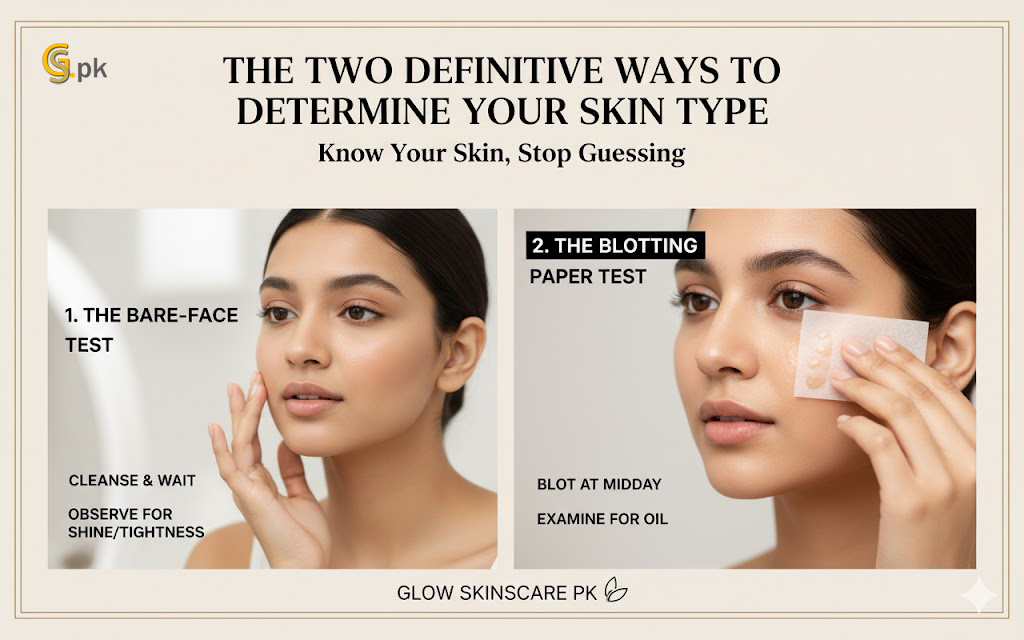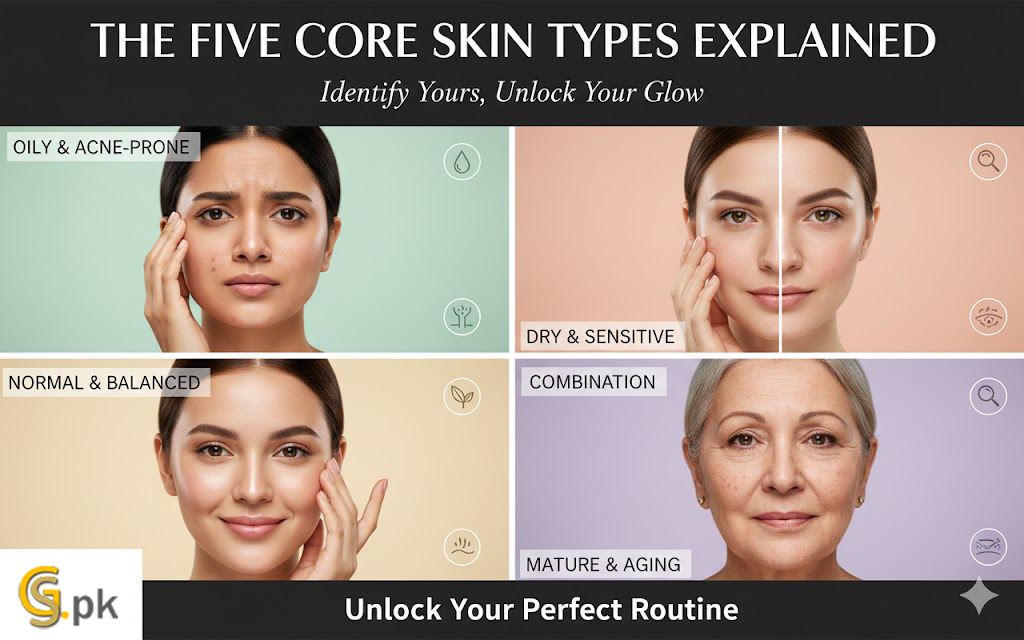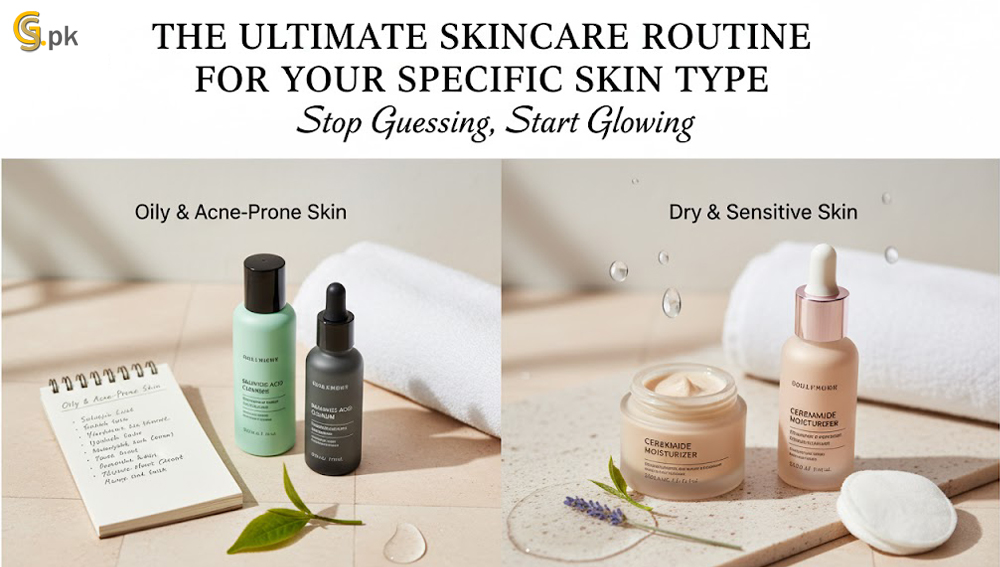How to Determine Your Skin Type (A Comprehensive Guide)
If you’ve recently started your skincare journey—perhaps after reading our [Skincare Routine for Beginners] guide—you’ve likely encountered a common roadblock: How to determine your skin type? This single piece of information is the most crucial factor in selecting the right products, yet it’s the step many people get wrong. Using products designed for oily skin on a dry complexion, or vice-versa, can sabotage your efforts, leading to irritation, breakouts, and general frustration.
In this comprehensive guide, we will break down the simplest, most effective methods for you to definitively determine your skin type, and explain the unique characteristics of each type. Getting this right is the first step toward achieving a healthy, lasting glow.
Why Knowing Your Skin Type is the Most Crucial Step
Think of your skin type as the foundation of your house; everything else—your cleanser, moisturizer, and serums—must be built to match it.
- Product Efficacy: A rich, heavy cream ideal for dry skin symptoms will likely clog pores and cause blemishes on oily skin. Conversely, a lightweight gel moisturizer perfect for controlling shine won’t provide enough hydration for a dry face.
- Preventing Damage: Misusing active ingredients (like Retinol or powerful exfoliants) can cause severe irritation, especially if you have sensitive skin characteristics. Knowing your type helps you introduce new products safely.
- Targeting Concerns: Knowing your skin type helps you understand the cause of a problem. For instance, flakiness might be due to dryness (lack of oil) or dehydration (lack of water). The right diagnosis leads to the right solution.
The Two Definitive Ways to Determine Your Skin Type

You don’t need a dermatologist to start. There are two simple, at-home tests that will give you a clear indication of your skin type.
1. The Bare-Face Test (The Gold Standard)
This test measures your skin’s natural oil and moisture levels after cleansing.
Instructions:
- Cleanse: Wash your face thoroughly with a [gentle cleanser]. Pat your skin dry with a soft towel.
- Wait: Do not apply any serums, toners, or moisturizers. Leave your skin completely bare for 30 minutes to one hour.
- Observe: Go to a well-lit mirror and observe your skin’s condition, paying close attention to your T-zone (forehead, nose, and chin) and cheeks.
Observations:
- If your face feels tight or flaky: You likely have Dry Skin.
- If your T-zone and cheeks are shiny: You likely have Oily Skin.
- If your T-zone is shiny, but your cheeks are tight/dry: You likely have Combination Skin.
- If your skin feels comfortable, soft, and balanced: You likely have Normal Skin.
2. The Blotting Paper Test (The Quick Check)
This test is best for confirming oil production after a few hours of wear.
Instructions:
- Wait: Wait until midday—around noon or 1:00 PM—before performing this test. You should have been wearing no makeup or just light skincare for several hours.
- Blot: Gently press a piece of blotting paper (or a clean, thin tissue) onto different areas of your face: your forehead, nose, chin, and cheeks.
- Examine: Hold the paper up to the light to see how much oil was absorbed.
Observations:
- If the paper absorbed little to no oil: You likely have Dry Skin or Normal Skin.
- If the paper is saturated with oil from all areas: You definitely have Oily Skin.
- If the paper absorbed oil only from the T-zone: You likely have Combination Skin.
The Five Core Skin Types Explained

Once you have performed the tests, use the following detailed descriptions to confirm which of the five skin types you fall under.
1. Oily Skin
Oily skin is characterized by an overproduction of sebum, the skin’s natural oil.
- Appearance: Shiny or greasy look, especially by midday. Pores appear enlarged and noticeable across the face.
- Feel: Smooth, but often feels congested or “thick.”
- Concerns: Prone to blackheads, whiteheads, and persistent breakouts/acne. Makeup tends to “slide off” or crease quickly.
- Skincare Needs: Products labeled oil-free and non-comedogenic. Needs lightweight, gel-based moisturizers and routine use of gentle exfoliants to keep pores clear. This is where ingredients like Niacinamide and Salicylic Acid excel.
- Sebum control, Large pores, Shiny complexion.
2. Dry Skin
Dry skin lacks enough natural oil (sebum) to maintain its own moisture barrier.
- Appearance: Dull, rough, or sometimes flaky complexion. Pores are typically small and barely visible.
- Feel: Tight, especially after cleansing. Can feel rough or cracked in patches.
- Concerns: Prone to redness, irritation, itching, and heightened visibility of fine lines. This is common in colder, less humid climates.
- Skincare Needs: Rich, cream-based moisturizers, and facial oils. Needs ingredients like Ceramides and Hyaluronic Acid to replenish the skin barrier and prevent moisture loss.
- Skin barrier function, Flaky skin, Small pores, Lack of oil.
3. Normal Skin
Normal skin is the most balanced type. It produces just the right amount of sebum.
- Appearance: Radiant, smooth, and healthy-looking. Pores are small and barely noticeable.
- Feel: Comfortable; neither tight nor oily.
- Concerns: Generally few problems, though it can react to strong environmental changes or harsh products.
- Skincare Needs: Focus on maintenance: [daily sunscreen], antioxidants like Vitamin C, and basic hydration.
- Balanced skin, Clear complexion, Minimal concerns.
4. Combination Skin
Combination skin is the most common type and presents two or more distinct skin types on the face.
- Appearance: Oily/shiny in the T-zone (forehead, nose, chin), but dry or normal on the cheeks and jawline.
- Feel: Oily and congested in the center, tight and sometimes flaky on the sides.
- Concerns: Dealing with both breakouts and dryness simultaneously can be challenging.
- Skincare Needs: Requires a strategy often called “zonal treatment.” You might use a gentle foam cleanser (suitable for both) but apply a mattifying gel on the T-zone and a richer cream on the cheeks.
- Oily T-zone, Dry cheeks, Zonal treatment.
5. Sensitive Skin
Sensitive skin is technically a skin condition that can occur alongside any of the above types. However, its needs are so unique that it’s often treated as its own type.
- Appearance: Prone to redness, inflammation, and flushing. Can appear patchy or irritated easily.
- Feel: Often itchy, hot, or reactive to physical touch, temperature changes, or new products.
- Concerns: Extremely reactive. Burns easily in the sun. Reacts poorly to fragrances, alcohols, and harsh exfoliants.
- Skincare Needs: Minimal ingredients are best (less is more). Needs products labeled hypoallergenic and fragrance-free. Focus on soothing ingredients like Aloe Vera and Centella Asiatica.
- Reactive skin, Hypoallergenic products, Redness relief.
Avoiding the Pitfalls: Skin Type vs. Skin Condition
Understanding the difference between your skin type (which is genetic and rarely changes) and your skin condition (which is temporary and can be treated) is key to solving persistent issues.
Conclusion and Next Steps
By taking the simple, at-home tests detailed in this guide, you now have the essential knowledge required to build an effective skincare routine. Knowing how to determine your skin type correctly eliminates the guesswork, saves you money on products that don’t work, and accelerates your journey to clear, glowing skin.
Now that you have your results, it’s time to find the perfect products and routine tailored for your needs.
➡️ Your Next Step: Read our comprehensive guide on [The Ultimate Skincare Routine for Your Specific Skin Type] to immediately start building your new regimen.





